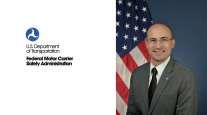Staff Reporter
Groups Take Legal Action Against HOS Final Rule

[Stay on top of transportation news: Get TTNews in your inbox.]
Three organizations and the Teamsters union have filed a petition in federal court challenging the final rule on changes to hours-of-service regulations, which takes effect in late September.
The petitioners — the Advocates for Highway and Auto Safety, the Teamsters union, Citizens for Reliable and Safe Highways and Parents Against Tired Truckers — filed their action Sept. 16 in the U.S. Court of Appeals for the District of Columbia Circuit.
The Federal Motor Carrier Safety Administration’s final rule, announced by Transportation Secretary Elaine Chao and FMCSA’s former acting Administrator Jim Mullen on May 14, includes four revisions that pertain to issues truckers have voiced concerns about, such as the 30-minute rest break and splitting up time in the sleeper berth.

The petitioners and Teamsters union filed a petition for FMCSA to reconsider the rule July 1, which the agency denied. Specifically, the groups are asking the court to review the final HOS rule and the denial of their petition for reconsideration of the rule.
“Because they’ve rejected that petition, now we’ve filed a petition with the U.S. Court of Appeals in the D.C. Circuit, so it’s kind of the next step in the process,” Peter Kurdock, general counsel for Advocates for Highway and Auto Safety, told Transport Topics. “This is just the first step in a very long journey.”
The final rule is scheduled to take effect Sept. 29. Kurdock acknowledged the petition’s journey through the court system likely will extend beyond that date.
“This action that we’ve taken in filing the petition with the U.S. Court of Appeals is really not going to affect that date,” Kurdock said. “This is a lengthy process. In all likelihood, the rule is going to go into effect at the end of September, and this process will continue after that date.”
Starting on September 29, 2020, truck drivers subject to Federal Motor Carrier Safety Regulations (FMCSRs) will be required to comply with the revised hours-of-service (HOS) regulations. What are the 4 changes? -- and for more information, see:https://t.co/tSJ8XOFaqr — FMCSA (@FMCSA) September 18, 2020
Fatalities in crashes involving at least one large truck are projected to have increased by 1% in 2019, while overall traffic fatalities are projected to see a decline, according to National Highway Traffic Safety Administration estimates. NHTSA released preliminary figures for the Fatality Analysis Reporting System data for 2019 on May 5.
The groups have expressed concern that the increased flexibility made possible by the final rule will exacerbate the issue of driver fatigue.
“I fall asleep on the job, my head hits the keyboard,” Advocates for Highway and Auto Safety President Cathy Chase said. “If a truck driver falls asleep, his [or] her head hits the windshield and that’s only part of the catastrophic outcome. Allowing operators to work longer hours and drive farther distances without proper rest breaks and other protections ignores science, data and expert opinion.”
Noting the revisions were crafted with consideration of thousands of public comments, ATA spokesman Sean McNally said the final rule provides flexibility without changing the fundamental HOS regulations.

McNally
“None of the changes under this final rule will allow additional driving time beyond current regulations,” McNally told TT. “The easiest thing to do in Washington is to say ‘No.’ For those objecting to this rule, it should come as no surprise, as this is all they do.”
FMCSA’s final rule will allow more flexibility for the 30-minute rest break rule by requiring a break after eight hours of consecutive driving and allowing the break to be satisfied by a driver using “on-duty, not driving” status, rather than “off-duty” status.
The rule also will modify the split sleeper berth exception to allow drivers to divide their required 10 hours off duty into two periods: an 8/2 hour split or a 7/3 hour split. Neither period would count against the driver’s 14-hour driving window.
Additionally, the rule modifies the adverse driving conditions exception by extending by two hours the maximum window during which driving is permitted.
The final revision involves changing the shorthaul exception available to certain drivers by lengthening the drivers’ maximum on-duty period from 12 to 14 hours and extending the distance limit within which the driver may operate from 100 air miles to 150 air miles.
The final rule is based on a proposed rulemaking that was announced Aug. 14, 2019. FMCSA officials waded through 8,000 public comments, gathered online and through in-person meetings, as they formed the final rule.
“By issuing this HOS regulation, FMCSA has bowed to special trucking industry interests at the expense of highway safety, seeking longer workdays for drivers who are already being pushed to the limit,” Teamsters union General President James Hoffa said. “We join this lawsuit to ensure that our members and their families are protected from fatigued drivers when they use our nation’s highways.”
Want more news? Listen to today's daily briefing:
Subscribe: Apple Podcasts | Spotify | Amazon Alexa | Google Assistant | More




